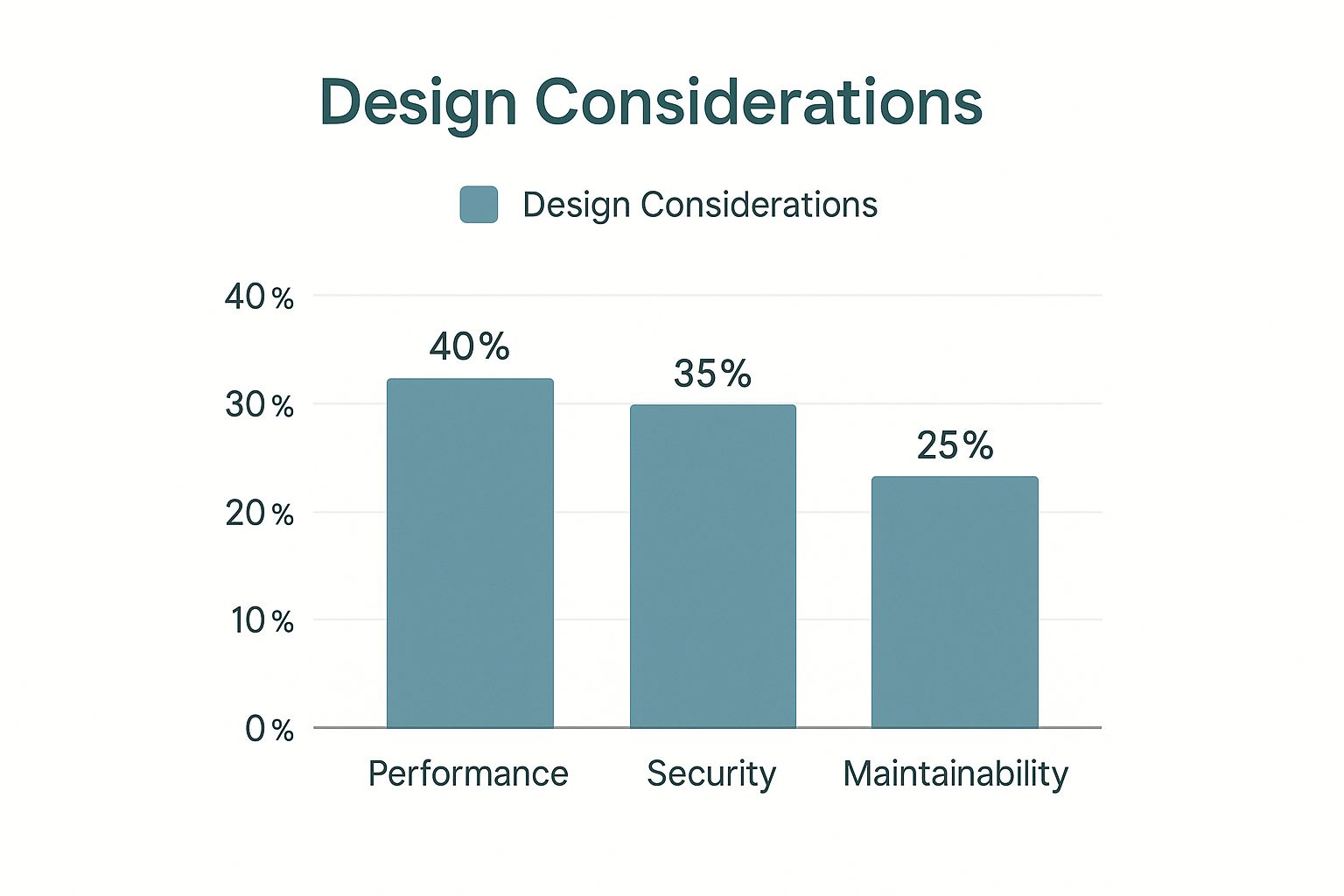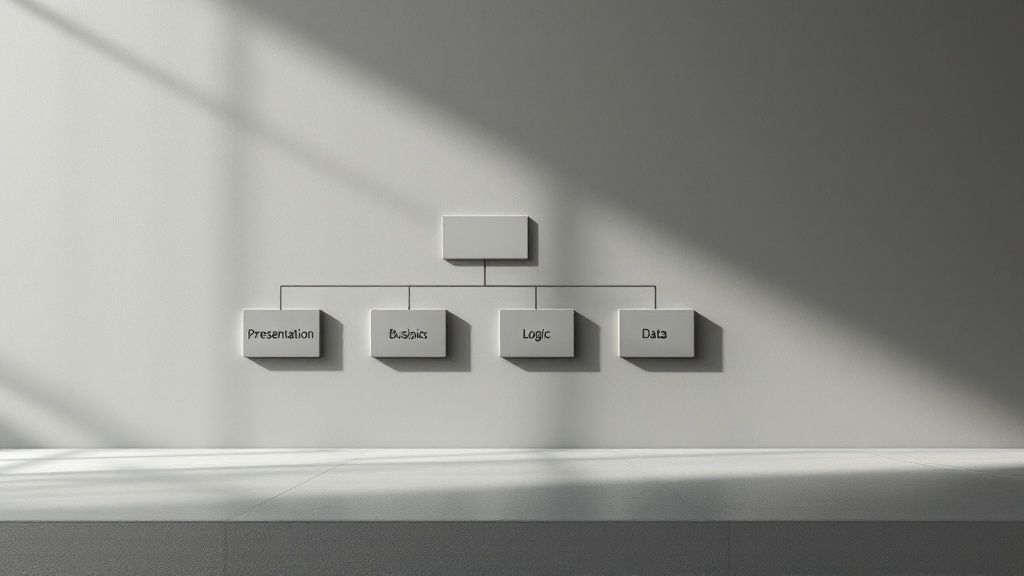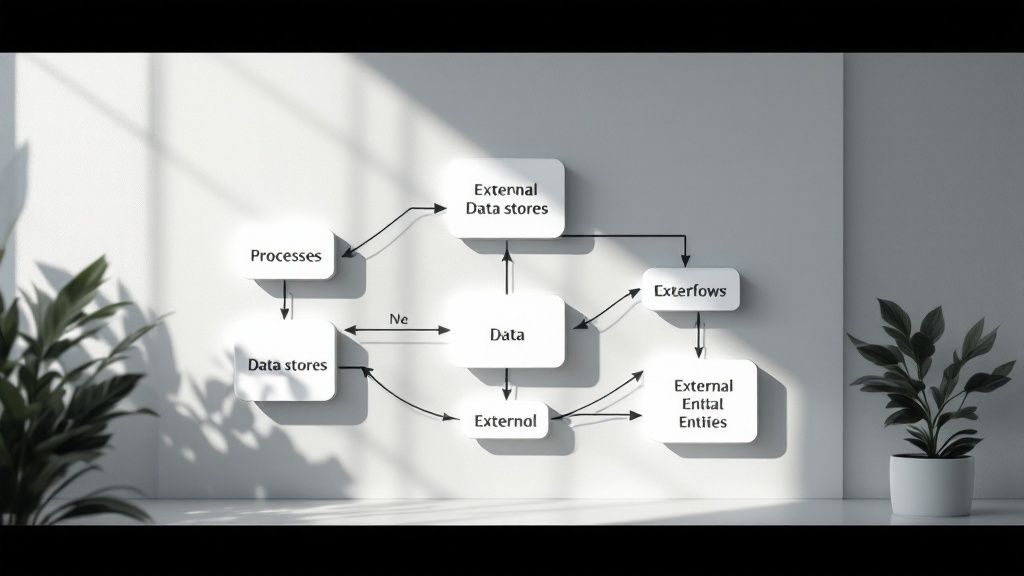Download our comprehensive software design description template. Learn to define system architecture, data design, and interfaces for better project outcomes.
Think of a software design description template as the architectural blueprint for your project. It’s the document that spells out exactly how a software system is going to be built, turning stakeholder wishes into a solid technical plan. It lays out the system’s architecture, all its moving parts, how they talk to each other, and how data is handled. For any development team, this document is their north star.
A Software Design Description (or SDD) is what connects the dots between what a project is supposed to do and the actual, finished product. You might be familiar with a Software Requirements Specification (SRS), which defines what the system needs to accomplish. The SDD takes that and explains how the development team is going to make it happen. It becomes the definitive technical reference for everyone involved.
Getting this distinction right is a huge deal for any project. An SRS is all about user needs and business rules. The SDD dives into the guts of the software—its internal structure and mechanics. For example, an SRS might say, “The system needs to let users upload photos.” The SDD would then detail the specific API endpoints, database schemas, and server-side logic needed to bring that feature to life.
A clear SDD isn’t just bureaucratic box-ticking; it’s a critical tool for communication and planning. It gets developers, project managers, and QA teams all on the same page, rallied around a single technical vision. When you use a well-thought-out software design description template, you force yourself to consider all the important technical details before a single line of code is written. That alone dramatically cuts down on confusion and expensive fixes down the road.
Here’s why it matters so much:
Industry standards have long confirmed how vital this document is. For complex projects, an SDD captures all the crucial design decisions, the overarching architecture, and the interfaces needed to build everything out. These documents can sometimes run into the hundreds of pages just to ensure absolute clarity. To see how this works on a massive scale, check out NASA’s approach to the Software Design Description.

For any serious development team, adopting a standardized software design description template is a critical move. Think about it: instead of reinventing the documentation structure for every new project, a template gives you a consistent, reliable framework from the get-go. This simple step immediately makes your projects more efficient and predictable.
This consistency means all the crucial design elements get captured the same way, every single time. Nothing important, from system architecture down to component specs, gets overlooked. The result is a much more organized development process where everyone—stakeholders included—knows exactly where to find the info they need. That alone makes for clearer reviews and far more productive feedback.
A standardized template really acts as a common language for the whole team. It gets developers, architects, and project managers all on the same page, aligned around a single source of truth for every technical decision. This shared understanding is huge for minimizing the kind of misinterpretations that often lead to expensive rework.
On top of that, it dramatically speeds up the onboarding process for new engineers. A new hire can get up to speed much faster by reviewing a document structure that’s already familiar, rather than trying to decipher a unique format for each past project. They can start contributing meaningfully in days, not weeks.
The data backs this up. A recent study showed that 78% of developers see a well-structured SDD as essential for maintaining code quality and supporting long-term maintenance. The same research found that teams using a standardized software design description template cut their project completion times by 12-15%, purely by reducing design misunderstandings. You can dig into these findings on software design document templates yourself.
At the end of the day, a good template helps you build a more robust and scalable product. By enforcing the documentation of key design choices and patterns, it ensures the system is built on a solid foundation from the start. This is where understanding core principles is invaluable; our guide on essential software design principles for building better applications shows just how deeply these concepts connect.
When it comes time to update or scale the system, a clear and consistent SDD becomes the go-to reference, making the whole process faster and less prone to errors. This long-term view is what separates successful projects from the ones that become a nightmare to manage over time.
A solid software design description template is so much more than a simple document. It’s the architectural blueprint that guides the entire development process from start to finish. To really be effective, it needs specific, clearly defined sections that cover every critical aspect of the system’s design.
If you skip any of these core components, you’re inviting ambiguity into the project, which almost always leads to delays and expensive rework down the line. Each section has a distinct job to do, and together they create a complete, holistic view of the technical solution you’re building. Think of these parts as the chapters in your project’s technical story.
This infographic gives a good sense of how teams often weigh key non-functional requirements within an SDD. Performance and security almost always dominate the conversation.

As you can see, there’s a common tendency to prioritize things that directly impact the user experience, like performance (40%), with critical safeguards like security (35%) following close behind. Maintainability (25%), while crucial for long-term health, sometimes takes a back seat.
Every truly robust SDD template is built on a foundation of core sections. These elements create a logical flow, moving from broad concepts down to the nitty-gritty implementation details. This structure is what makes the document easy for everyone—from developers to project managers—to navigate and actually understand.
To give you a quick overview, here’s a table summarizing the essential sections you’ll find in any good SDD template.
These sections are the non-negotiables. They ensure that every critical angle is covered, leaving no room for guesswork.
Here’s a slightly deeper dive into what each of these non-negotiable parts of your template must include:
To see how all these pieces fit together in a real-world document, checking out a complete software design description example can provide some invaluable context.
While these core components are pretty much universal, the best SDD template is one that’s tailored to your project’s specific needs. For a small, less complex app, you might be able to condense a few sections.
On the other hand, a massive enterprise system might require extra sections to cover things like regulatory compliance or complicated integrations with legacy systems. The trick is to start with a comprehensive structure and then adapt it to provide the maximum possible clarity for your team and project.

This is where the high-level technical vision really starts to take shape. The system architecture section of your software design description template is the foundational blueprint, translating abstract ideas and requirements into a concrete structural plan for the entire development effort. It’s where you pin down the architectural pattern that will dictate how everything fits together.
You might, for instance, go with a Monolithic architecture, where every component is tightly woven into a single, unified service. Or, you could opt for a Microservices architecture, breaking the system down into a collection of small, independently deployable services. Each path has massive implications for development, scalability, and how you’ll handle maintenance down the road. This section isn’t complete without diagrams—usually Unified Modeling Language (UML)—to give everyone a clear visual of the system’s structure and how its major parts talk to each other.
Just as critical is the data design section. This part of the document gets into the nitty-gritty of how your application will store, manage, and process information. A poorly thought-out data model is a recipe for disaster, leading to frustrating performance bottlenecks and major scalability headaches later on. This is one area where you can’t afford to skimp on the details.
At a minimum, you need a comprehensive data dictionary that defines every single piece of data your system handles. You’ll also need to lay out your database schemas and create detailed Entity-Relationship Diagrams (ERDs). For developers, these visual aids are absolutely indispensable; they clarify the relationships between different data entities and the rules that govern them. To see how these pieces all come together in practice, checking out a complete software design documentation example is a great way to connect the dots.
Getting the data design right is crucial for building an application that can actually grow. Following established guidelines from the get-go is non-negotiable. You can learn more about these top database design best practices to make sure you’re building on a solid, scalable foundation.
Nailing down the clarity in these two areas helps you sidestep some of the most common and costly mistakes in software development. By explicitly defining the system’s structure and how data flows through it, you establish a strong foundation for performance, scalability, and future maintainability.
Of course, manually creating and updating all these diagrams and descriptions is a huge time-suck for developers. That’s where DocuWriter.ai comes in. It automates the generation of UML diagrams and data dictionaries directly from your code, ensuring your SDD is always a perfect reflection of your system’s current state.
Once you’ve sketched out the high-level architecture, it’s time to zoom in. The next logical step is to break the whole system down into its individual building blocks. This section of your software design description template is all about the granular details—what each component does and how they all talk to each other. We’re moving from abstract diagrams to a concrete plan developers can actually build from.

Think of each component as a self-contained module with a single, clearly defined job. For instance, a “User Authentication Service” should only handle logging users in and managing their sessions. Nothing more. This kind of modularity is absolutely essential if you want to build a system that’s easy to manage, test, and update down the road.
When you get this right, you unlock the ability for parallel development. With clear boundaries and responsibilities defined, multiple teams can hammer away on different components at the same time without tripping over one another. It’s a huge accelerator for the development lifecycle.
For every component you identify, you need to provide a detailed breakdown of its guts. This isn’t just a high-level summary; you have to get into the nitty-gritty of its logic and dependencies.
Getting this level of detail down on paper eliminates ambiguity. It ensures that when a developer builds the component, it does exactly what you expect and plugs into the larger architecture without any nasty surprises.
Just as important as defining what components do is documenting how they communicate. The interface specification is the contract that governs all these interactions, and in modern systems, that almost always means Application Programming Interfaces (APIs). A thorough interface description is non-negotiable for any decoupled system.
Your documentation needs to meticulously detail every single aspect of the API:
/users/{id}).Documenting these specs makes testing worlds simpler and encourages the creation of reusable, independent services. Believe me, when you need to extend or maintain the system later, you’ll be thankful for this clarity.
Of course, manually creating and maintaining this level of detail is a massive chore. A tool like DocuWriter.ai can automatically generate API documentation and component diagrams right from your codebase, ensuring your software design description is always accurate and up-to-date without the manual effort.
Let’s be honest, manually creating and updating a software design description template is a huge time sink for developers. It’s one of those tasks that feels necessary but always pulls you away from what you do best: writing code. In a world of tight deadlines, we need a smarter way to keep documentation and code in perfect sync.
This is exactly why we built DocuWriter.ai. It’s an AI tool that takes the pain out of technical documentation by generating it for you. It can create diagrams, descriptions, and up-to-date documents straight from your source code. The result is an SDD that actually reflects the current state of your system, which means no more outdated docs and wasted development cycles.
Of course, AI isn’t magic. While DocuWriter.ai delivers incredibly detailed documentation, a quick human review is always a good idea to add that final touch and ensure it perfectly captures your project’s unique details. If you’re new to this, there are some great techniques for refining AI-generated content that can help you get the best possible results.
Stop letting documentation be a bottleneck. Try DocuWriter.ai today.
Digging into technical documentation templates always brings up a few practical questions, especially when you’re trying to fit a software design description template into your team’s existing groove. Let’s tackle some of the most common ones.
A big one we hear a lot is whether SDDs even make sense anymore in a world that’s gone all-in on agile. The short answer? Yes, definitely. But its role has changed.
Yes, absolutely. While Agile threw out the old playbook of creating massive, static documents upfront, the SDD didn’t disappear—it just evolved into a living document. An Agile SDD isn’t some stone tablet you carve before writing the first line of code.
What teams usually do now is start with a high-level architecture that lays out the core structure. From there, as the project moves forward, they flesh out the details for individual components and interfaces sprint-by-sprint. Using a template ensures that as this design grows, it stays coherent and easy for new people to understand. It keeps the documentation lean but incredibly effective.
Getting this straight is crucial for planning any project effectively. Think of it this way: the Software Requirements Specification (SRS) is all about the what. It captures what the system needs to do from a user’s point of view, covering all the functional and non-functional requirements without getting into the weeds of implementation.
The Software Design Description (SDD), on the other hand, is the how. It’s the technical blueprint that lays out exactly how the system will be built to meet all those requirements from the SRS. The SRS is the problem; the SDD is the solution.
The right tool really boils down to what your team needs for collaboration, drawing diagrams, and maybe a little automation.